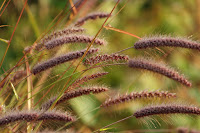What is so special about this invasive species that
sends me into raptures? For one, a single individual goes through ‘50 shades of red’, so to say, in an entire life-cycle. What’s more, a full field
reflects the same—simultaneously—as in a time-lapse gif! The description ‘purple’ in this fountain grass, therefore, is bit of a misnomer. Before I knew better, I thought that the stalks at various stages of growth were different species altogether. A sample of the spectrum of shades the grass runs through in its life-time looks like this: blood red, maroon, wine red, plum, burgundy,
crimson, scarlet, brown, wood purple, and even pink, before it loses
its blush and becomes ‘Plain Jane’ beige, cream, and buff. During these stages
the hairy spikes and sharp contours of the taut seed-heads go through their own
metamorphoses becoming more blunted in appearance and fluffy.
A field of purple grass is a photographer’s delight. The plumes blush at the first flush of the sun. The filament-like hairs on their
margin throw up a golden aura that is hypnotic. My predicament then is like a
hungry lion in the midst of a mega herd of wildebeest. There is stimulation overload as the stalks
outdo each other vying for the attention of my lens. I have shot individual
stalks with character, 'strawberry popsicles' laden with dew drops, bouquets of
burgundy and other monochromes. At sunset hour, the grass heads internalize the glow
of the retreating sun providing stunning backlit shots. That is as much as
stalks as a ‘subject’ is concerned.
The fountain grass gets me excited for other reasons. I
love green that dominates our countryside, but as a nature photographer I find the
virid canvas boring and am always on the lookout for alternatives for a vivid
bokeh (a Japanese term for the much-sought-after or desired background blur by creative photographers). I can anticipate countless possibilities to
capture wildlife against the backdrop of the Pennisetum.
Butterflies and
dragonflies fancy this firmament and birds such as chiff-chaff and grassbirds
find it a good place to hide and forage. The blood-red male Scarlet Skimmer aka
Crimson Darter aka Ruddy Marsh Skimmer dragonfly (and its golden
counterpart) cling to the stalks disappearing under your very nose, in a
Houdini act. When camouflage artistes that are symbiotic to this ecosystem
present themselves on the stalks it is sheer magic.
At the end of its
life-cycle, the seeds that are ever-so-delicately held together on the stalks
cleave at the slightest hint of breeze leaving behind bare needles. Often times
as seeds shed off the stalk, cottony wisps stick out. On closer scrutiny—this
once—I discovered a white spider, well camouflaged!
All Photographs in this blog and website are the Author's Original work/Copyright.





















